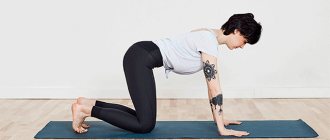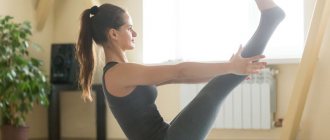Upward facing dog
This pose helps in working the long and oblique abdominal muscles, strengthens the abs and improves blood circulation. Lie face down on the floor with your feet shoulder-width apart. Arms bent at the elbows, palms next to the shoulders - as if you are about to start push-ups. Inhale and slowly lift your upper body off the floor, leaning on your hands. Make sure your stomach is pulled in and your legs are slightly raised off the ground. Exhale, hold in this position for 20 seconds, then slowly return to the starting position.
Yoga for Abs, Glutes and Runners
What is yoga, and what does it give to modern man?
There are many definitions of yoga and each deserves an entire philosophical treatise. My favorite:
“Yoga is a way of bringing all activities of the mind under control.”
Digest it.
Let's continue. You can try to find other definitions, and there you will find the words “mindfulness”, “con”, “study”, etc., and in none of the classic definitions you will find the words “abs”, “buttocks” or “for runners”. You won’t even see the words “painful back” or “exercise”. Yoga does not work with body parts; the goal of yoga cannot be the abs. Even for a runner.
Yoga works with the mind, including through the body. And the form of the body - Asana - is necessary for the practitioner to work on attention; it is convenient and effective, because we have nothing closer and more sensitive than our own physical body. And the practitioner receives toned buttocks and a straight back as a bonus. And this is important to understand and not devalue.
By pumping up your abs in navasana or strengthening your buttocks with utkatasana, you are doing physical fitness, not yoga. You do yoga when you miss a workout due to an injury, and pacify your pride and heal, rather than run on, ignoring the pain for fear of losing shape.
Yoga is working with the mind, concentration, attention, in particular with blind spots in the body, and even with the inclusion of an internal corset in the running process. But not his upload. Or stretching.
Yoga in the context of asanas is the work of the mind to improve the physical processes of the body. When my athletes ask me what this or that complex is aimed at, I invariably answer that any yoga class is an exercise to tighten the inner corset. Not a single student has yet asked me what exactly I mean, and I will say here - I mean not only the notorious bandhas (internal core muscles) and the diaphragm in particular, I mean “gather the attention of the mind in the body”, “listen body”, “build movement from, “to be here and now as much as possible, so that then and then your inner corset will be with you, and you will become a little more perfect.” If they ask me what muscles this or that asana or ligament is used for, I usually just don’t answer and wait for yoga to awaken in a person, and he will answer this question for himself, that yoga is a practice for putting under control all the activities of the mind. Through working with the body and breath.
Therefore, do not call stretching your lower back in bends or stretching your buttocks yoga as yoga. Don't anger the Universe.
And may the force be with us!
#yoga
Photo: Evgenia Avramenko @botafogo_russia
Udhrva Prasarita Padasana
photo 1
Technique
1. Starting position – lying on your back with your legs raised up, arms along your body (photo 1).
2. As you exhale, lower your legs down, while inhaling, lift them up.
3. Perform the exercise several times in the rhythm of breathing until slightly tired.
photo 2
4. Then fix your legs at an angle of 60 degrees to the floor (photo 2)
5. Then 45 degrees to the floor.
photo 3
6. If possible, fix your legs as close to the floor as possible (photo 3).
7. Hold your legs until there is a slight trembling in the abdomen.
8. Then lower your legs down, relax your stomach and lower back.
Effect
The abs and lower back are strengthened, the hamstrings are stretched, and the basis for performing Navasana is created.
Boat pose
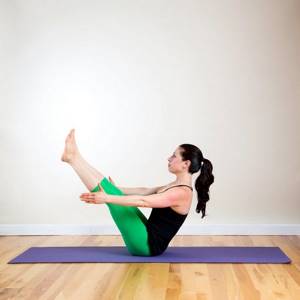
This asana engages all the abdominal muscles, get ready to work it out!
- Sit on the floor with your legs extended forward. Bend your knees and lift them so that your knees touch your chest and your shins are parallel to the floor. Gradually straighten your legs and tilt your torso back. It is not necessary to completely straighten your legs at first; the main focus here is on your abs;
- Hold this asana for five breaths.
Exercise sets
Boat pose helps strengthen your abdominal and leg muscles. Sit on the mat, shift the center of gravity to the ischium. Lean back, lift your legs straight. For balance, extend your arms horizontally. If you are a beginner, bend your knees. To increase the load on the abdominal group, pros spread their hands to the sides. The asana has an alternative - Ardha Navasana. The rules for performing yoga are the same, only the intertwined fingers are placed at the back of the head.
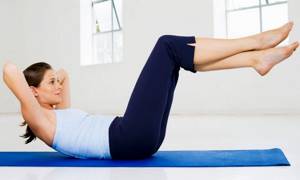
Crescent
Perform Arhu Chandrasana while standing with your feet wide apart. Stretch your left arm above your head and simultaneously bend forward. Touch the floor with your other palm and lift the opposite limb until it is parallel to the floor. If you have good balance, rotate it at the hip joint in a short amplitude. Don't forget to watch your breathing.
Adho Mukha Svanasana
The exercise is reminiscent of a dog stretching after sleep. In addition, abdominal yoga strengthens the buttocks and hamstrings. Get down on all fours, and as you sigh, transfer the fulcrum to your palms, placing your fingers straight forward. Straighten your legs, point your tailbone up, look at your knees. If your body is flexible, stand on your head with your arms straight forward.
"Cobra"
Bhujangasana helps remove belly fat, strengthens the buttocks and stretches the back well, improves the functioning of the gastrointestinal tract.
- Sit on the mat face down, with the palms of your bent arms resting on your chest line.
- Slowly straighten your elbows, pushing your chest forward.
- Bend your back as far as possible without lifting your hip bones from the floor.
- Hold, sequentially twisting vertebra by vertebra, return to IP.
Virabhadrasana
This is an effective way to tone your lateral abs, lats, and hip adductors. There are 2 options for the exercise.
- Standing with your feet wide apart and your stomach pulled in, raise your hands parallel to the top of your head and bring your palms together.
- Turn to your side and smoothly lower yourself to one knee, leaving the other straight.
- Lower yourself until you form a right angle, perform a breathing cycle and straighten up.
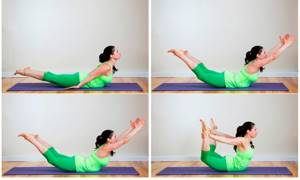
Repeat similar steps with the opposite leg.
In version No. 2 the principle is the same, only the arms are spread horizontally. Perform the complex for losing weight on the abdomen and sides in the morning every day or every other day, duplicating each pose 5-7 times. For fastest results, practice yoga twice a day. Video of effective yoga poses
What to do if you want to have a thin waist?
In the days of our ancestors, women going to the gym was unthinkable. However, wasp waists are often present in the paintings of great artists. Does this mean that the girls trained away from prying eyes? Of course no! The visible result was achieved by wearing ordinary corsets, and often led to huge health problems. Modern women sometimes resort to such deception - but you can’t wear a corset to the beach, and you can’t go to bed with it. And therefore, there is only one cardinal way to change your figure - proper nutrition and specially selected exercises for the abs and waist.
Proper nutrition

Reducing your belly without limiting yourself to certain foods is impossible. This is due to the fact that excess of some of them (for example, fast carbohydrates) is transformed into fats faster than the body is able to burn. As a result, the fat layer on the stomach and sides will increase, and sports training can only strengthen the muscles located deeper. Moreover, in this case, internal organs may also become obese, which sooner or later will negatively affect health and require drug treatment, or even surgical intervention.
This is interesting: Skorokhod sizing chart for children's shoes
What products fall into this category? First of all:
- baked goods (fresh bread, buns, pies);
- other dough products (dumplings, dumplings, pasta);
- sweet confectionery (cakes, chocolates, etc.);
- carbonated drinks with a high sugar content (especially energy drinks, Coca-Cola, etc.);
- fatty meat and offal;
- foods high in salt that retain water in the body (smoked sausages, chips, etc.).
This does not mean that you need to switch to just greens and water. Nutrition must be balanced and contain a strictly defined amount of proteins, fats and carbohydrates (mostly slow ones) in the correct ratio.
Exercises
What can exercise do? A properly selected complex for beginners will allow you to get rid of excess calories and tighten your abdominal muscles at a reasonable speed. These exercises do not present any difficulties, since for the most part they are not so much strength training as aerobic. Before performing them, a light warm-up is required to warm up the muscles - 5-7 minutes of running, jumping, squats, and even just dancing to music.
List of contraindications
It has been scientifically proven that yoga has a significant effect on most systems and organs in the human body. Therefore, with various pathologies and serious illnesses, it will not be possible to practice yoga.
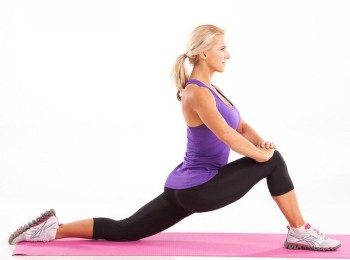
The main contraindications to performing asanas on the abs are:
- acute respiratory diseases;
- the presence of an umbilical or inguinal hernia;
- pathology of the digestive system (appendicitis, pancreatitis, gastritis);
- diseases of the cardiovascular system;
- high blood pressure;
- a sharp deterioration in well-being after the first classes.
In connection with all of the above, it will be very useful to visit a doctor and consult about attending yoga classes. He will be able to assess the likelihood of various risks and identify the absence or presence of possible contraindications.
Get ready to warm up!
If you start training without this very important element of training, then your risk of receiving all kinds of injuries to both ligaments, joints or muscles increases many times over. Additionally, be sure to consider your current physical fitness.
The recommendations that you will find below are a very average model, but you need to start only from the strength of your body. Moreover, even highly trained athletes have periods of decline, for example, during menstruation or poor health. It also happens that sometimes you just aren’t in the mood. In any case: you shouldn’t force your body trying to surpass yourself.
Remember also that few people manage to do everything perfectly right away, so don’t rush, chasing results and neglecting the technique of doing the exercise. During the preparatory part, you can do bends, as well as rotations with your hips; twisting your torso will also help you warm up.
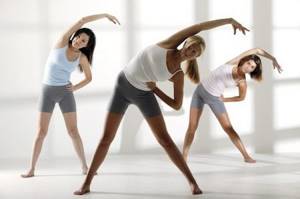
In addition, there are quite simple asanas and even elements of ordinary exercises, which every schoolchild is familiar with.
These could also be techniques from Ashtanga yoga. Try rubbing the major joints of both your arms and legs with vigorous movements. First make them clockwise and then counterclockwise. Try to correctly calculate the load not only during one workout, but also for the whole week.
Choose the right regime: do not do yoga only at the end of the week, without devoting time to it on the rest of the days, then you will have to go through a difficult recovery, and in general it is extremely difficult to progress in this mode.
The most suitable regularity is training every 2-3 days (if you have an average level of physical fitness).
Don’t forget also that no amount of asanas will help you get rid of excess weight or correct the shape of your stomach if you don’t watch your diet.

Balancing Star
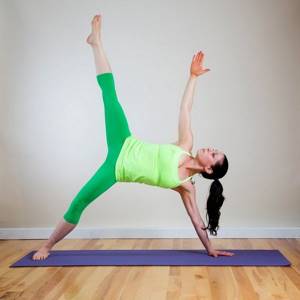
This is a rather difficult asana for beginners; when mastering it, you can stick your hand to the wall.
- Stand in Downward Facing Dog asana and bring your feet together. Place your right hand a little to the left in front of you so that it is in the center of the mat. Place your right leg slightly forward, your foot should be well pressed to the floor and your toes turned to the left. As you inhale, turn your torso and raise your left arm up. then lift your left leg up;
- Look at your raised hand and hold this asana for five breaths. It will be easier for you to maintain balance if you sufficiently tense your lower torso muscles.
Repeat the asana on the other side.
Headstand
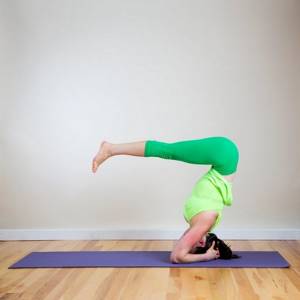
Working out the back and abdominal muscles.
- Get on all fours, lower your elbows to the floor and clasp your fingers. Your hands form a semicircle;
- Lower your head to the floor, the back of your head will touch the palms of your hands, the top of your head will be on the mat. The head stands vertically on the floor. Once you feel that your head and arms are firmly on the floor, straighten both legs and walk as close to your face as possible;
- Place your hips over your shoulders, keeping your elbows firmly on the mat. Raise both legs up;
- Stay in the asana for five breaths. The jaw should be relaxed. Inhale, and as you exhale, slowly lower both legs towards the mat so that they are parallel to the floor. Hold the asana for another five breaths;
- Inhale, as you exhale, straighten your legs up again, repeat this five times;
- Gently lower your feet onto the mat, lie on it with your stomach down, and rest a little. You cannot get up immediately after this asana.
Preparing for Eight Bend Pose
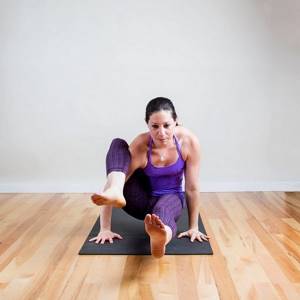
The asana itself perfectly works the entire upper body. To develop the abs, a preparatory pose for the Eight Bent Parts of the Body asana is sufficient.
- Sit down and stretch your legs straight out in front of you. Bend your right knee, place your right hand under your right leg, with your left hand pull your right knee as high as possible on your right arm;
- Bend your right arm slightly at the elbow to make it easier to support your right knee. Press your palms into the floor, tighten your abs, and as you inhale, lift your hips off the floor. If you can, lift your left leg off the floor as well. After five breaths, you will probably feel a burning sensation in your abdominal muscles.
Warrior Pose 3
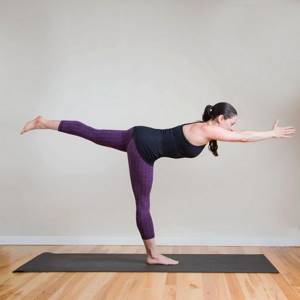
Balancing on one leg really develops your lower torso muscles! If you don't tighten your abs properly, you'll likely fall. The following tips will help you maintain balance.
- Stand straight with your feet together. Inhale and spread your arms out to the sides. For a more complicated version of the asana, stretch your arms up;
- Exhaling, bend forward and lift your right leg back horizontally to the floor;
- Pull your stomach towards your spine and hold the asana for five breaths. Then straighten up and lower your right leg, repeat the same for your left leg.








